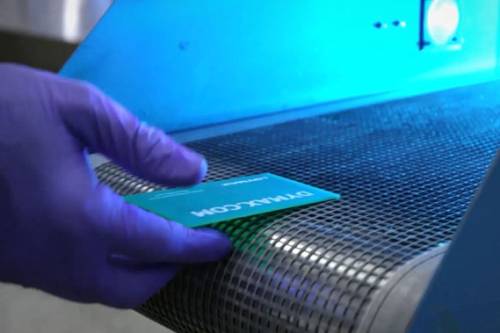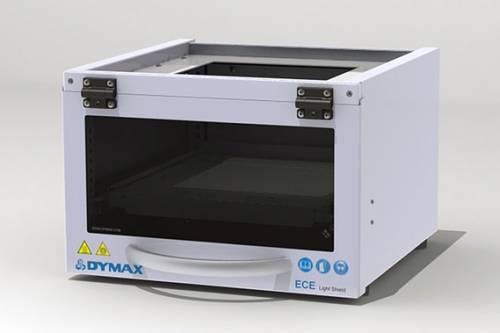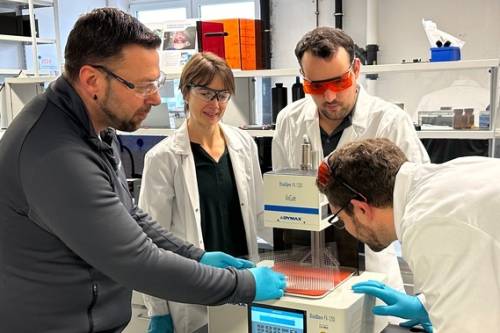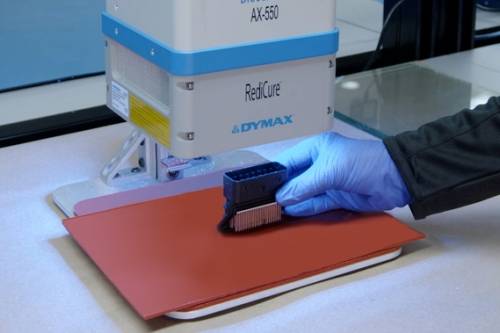Ways to Limit Exposure When Using UV Light-Curing Systems
Ultraviolet (UV) light is a form of electromagnetic energy invisible to humans. UV light falls below visible light on the so it does not trigger the natural defenses of the eyes, such as pupil dilation experienced with bright visible light. For this reason, it is important to use personal protective equipment and intensity measurement devices and not disable any safety controls designed for the UV light source to limit exposure.
Many people often mistake the bright light coming off these systems as harmful, but what they see is harmless visible light. While all UV light has the potential to hurt an employee when used carelessly, shortwave UV energy (UV-C) poses the most significant risk to those using these light sources. Most UV sources sold within the industrial light-curable adhesive market incorporate safer UV-A energy. Reviewing the specifications for the UV source before using it is essential.
An operator places a printed circuit board into a UV light-curing conveyor.
In industrial settings, users often misunderstand UV exposure, but it is in these settings that manufacturers have the most significant control over a worker's health and safety.
Addressing Stray Light
UV light-curing systems frequently have safety or engineering controls built into them. These controls, such as shielding, safety interlocks, intuitive design, and light-absorbing plastics, allow operators to use them without exposing themselves to harmful ultraviolet light.
A light-curing system, such as a Dymax 2000-ECE flood-curing lamp, can emit stray, visible light between its sections. This light can cause concern amongst users who believe the visible light contains UV-A. To address these fears, manufacturers can utilize a radiometer. This device measures light intensity and can demonstrate the amount of UV light an employee is exposed to while operating a UV-curing system. Taking the radiometer's sensor and holding it near a person's exposed skin while the unit is on and then comparing this to the exposure a person receives outside on a sunny day will show the individual is experiencing greater exposure from the sun.
A radiometer can also help prove that the amount of stray light emanating from a curing unit in the visible wavelength does not contain UV-A. UV-A does not reflect from most surfaces, so it is absorbed and turned into heat when it hits a surface. The 2000-ECE flood curing lamp is dichroic and reflects the UV-A energy directly downwards towards the work surface. If the system employs a ZIP™ shutter, a radiometer can verify if it is closing completely so no stray light escapes. When the curtain is closed, it should measure zero UV intensity. It is vital to match the radiometer to the UV wavelength being measured.
Radiometers can measure the amount of stray light emitted from a curing unit.
Employing Personal Protection Equipment
Other ways to protect an operator from light exposure include shields, goggles, glasses, face shields, gloves, and long sleeves.
Manual (3-sided) and electric Light Shields for flood-curing lamps can offer users 360° eye and skin protection from ultraviolet and visible light while allowing clear visibility of curing parts. However, wearing UV light-blocking safety glasses or goggles is still necessary as an extra precaution against stray light or accidental exposure.
Protect users from light exposure by using a light shield.
Anyone who can visually see the light should wear UV eye protection when utilizing any broad-spectrum or LED curing system because both systems generate light in the UV-A wavelength range. Dymax carries eye protection solutions that are rated to ANSI 87.1 with a maximum UV-A absorption to reduce brightness and irritation associated with a high-intensity light.
Employees wear UV eye protection while working with UV equipment.
Using gloves to protect hands from UV exposure is another option. At Dymax, we use disposable, powder-free nitrile gloves. We do not recommend a particular brand or type of glove, but being opaque or UV-blocking would be ideal.
Another effective PPE solution is to wear a long-sleeved lab coat to protect the skin from harmful UV exposure.
Wear gloves and a lab coat to protect yourself from UV light exposure.
Wearing a lab coat and UV-blocking gloves and using a customized fixture to hold two components together underneath a curing unit may also be employed. Using the appropriate PPE along with a fixture will keep hands and arms away from stray light and be effective from a safety and consistency standpoint.
Industrial UV light sources are safe and easy to use with the correct personal protective equipment, use of radiometers, and appropriate training. Teaching employees how to protect themselves from UV exposure and training them to work safely around these UV systems will minimize any potential risk of harm.
_________________________________________________________
Enjoying This Content? Let’s Stay Connected.
If you’re finding value in our insights, why not get more of it—delivered right to your inbox? Subscribe to receive the latest technical articles, white papers, product news, and expert tips.





